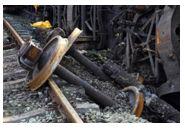Falls while working at height it’s the main cause of death in the workplace, thousands of injuries and fatalities happen every year around the world.
1) What types of work equipment are suitable for working at heights?
When working at a height, you need to ensure you use the right eight pieces of equipment and secure it safely to your person. Equipment dropped from heights can cause fatalities to those below and could even cause you to lose balance. Be sure to use tool lanyards and work tool belts to safely secure your tools before working on a ladder.
Furthermore, always ensure you are using the right scaffolding equipment or ladder for the job. Failure to use the correct height equipment could result in instability when working at height and could potentially be fatal – so be sure to use equipment that works in conjunction with your risk assessment. You can find plenty of equipment suitable for working at heights here.
2) What is a risk assessment?
A risk assessment is part of The Work at Height Regulations. This is an assessment that is conducted prior to working at height operation to identify what the hazards are and the level of risk to the worker. A risk assessment examines all the situations that could result in an injury and allows you to take steps to avoid any harm occurring.
To help you create your own risk assessment, we’ve put together a list of things to consider when conducting a Working at Height Risk Assessment.
3) Who is competent to work at height?
One of the main requirements for working at height operation is to enlist an employee who is competent to work at height. This refers to someone who has been trained to work at height and has the appropriate qualifications and experience. It is the manager and supervisor’s job to ensure those working at height are competent and suitably trained in this field.
If a worker regularly works at height, they should attend a working at height safety training course to certify that they are fully qualified to work at height safely. If you would like to be qualified to work at height you may be interested in our Working at Heights Training Course. This course will prepare you to work at height by teaching you all the necessary safety procedures.
4) How can I help stop someone from falling when working at height?
If you’re an employer with employees who work at heights, you can help prevent any falls by safeguarding the area. Using items such as working platforms with rails, access equipment, and durable PPE equipment can help stop your workers from happening upon any nasty falls.
As a safety professional, it is your job to protect your workers, so make sure you provide the best quality safety equipment. Safety is always more important than cutting costs.
5) What is a work-restraint or work-positioning system?
Work-restraint systems are used to prevent falls. They rely upon PPE such as a safety harness and lanyard and will be attached to the worker. The work-restrain system will prevent the worker from accessing dangerous positions. For example, a work-restrain lanyard could be adjusted to slightly shorter than the length of the work platform, thus stopping the worker from reaching the edge of the platform.
A work-positioning system works in a similar way. They include a harness connected to a strong anchor and keep the worker in the same place as they work at height. The tension will keep the worker suspended and will prevent any falls. However, both work-restraint and work-positioning systems need to be watched carefully to ensure their safety.
6) What should I do about any falling objects?
Falling objects should be prevented through the use of tool lanyards and the minimal use of any loose equipment or materials. If using scaffolding (especially near a public area), nets and platforms should be used to help prevent this issue. Falling objects could be fatal to any workers or pedestrians below, so all measures should be taken to avoid this occurring.
It is incredibly important to always be safe when working at heights, so we hope this has helped answer some of your working-at-height safety questions.
Download Now for FREE!!
Available only for all registered Users, does not require any payment to download.
| Title | |||
|---|---|---|---|
|
Mechanical power transmission apparatus 1 513 downloads |
Checklist, Free Files | October 21, 2022 | Please login to download |
|
Machine guarding 1 513 downloads |
Checklist, Free Files | October 21, 2022 | Please login to download |
|
HEALTH AND SAFETY MANUAL 1 13409 downloads |
Free Files, Learning/Training | October 14, 2022 | Please login to download |







